RIOTS AND DEMONSTRATIONS IN CHINA
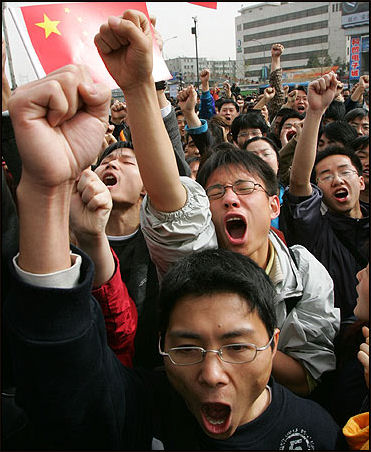
Most protests are localized and deal with complaints about local issues and are directed at local officials, bosses or employers not Beijing or the system, and they do not present a threat to the Chinese government. Sometimes the government tacitly allows protests to serve its political interests such as ousting a corrupt official. Student demonstrations have traditionally been held at the end of the term in December and January. While Communist party rule is not directly threatened by such incidents of unrest, officials fear they could coalesce into broader, more organised challenges to their power.
Chinese authorities use the term "mass incident" to describe riots, demonstrations and group protests, petitions, and strikes, both peaceful and violent. The term appears to cover group actions ranging from minor work stoppages to serious riots. Sometimes the term is used to describe a group protest involving more than 100 people. Once regarded as taboo and still illegal, they occur surprisingly often. The right to demonstrate is written in the Chinese constitution but demonstrators are supposed to give five days notice and provide a list of all the participants.
Demonstrations are largely seen as a means of releasing pressure. They have almost become the standard way of dealing with local issues. On a sidewalk on the opposite side of Tiananmen Square from the Great Hall of the People protesters gather to air their grievances. Cell phones and microblogs have made it easier for protesters to contact one another and recruit help and support from neighboring villages. They have also made it easier for protesters to communicate with NGOs and lawyers in the cities and get information, advise and legal help.
Articles on PROTESTS AND CORRUPTION factsanddetails.com
Protests and Demonstrations Numbers in China
The number of reported "mass incidents" rose from 8,700 in 1993 to more than 90,000 in 2006, according to the Chinese Police Academy. There were about 180,000 in 2010, according to Sun Liping, a Tsinghua University sociologist. According to the New York Times authorities recorded 127,000 so-called mass incidents in 2010 but most were too small to gain wide notice. According to figures from the China Academy of Social Sciences fights over land account for 65 percent of rural “mass conflicts” and is also a serious problem in cities.
The Guardian reported: "To some extent, the exponential increase is because of improved reporting of incidents that once would have been buried by the state press. Nowadays, the minute a window is smashed, somebody will whip out a cellphone camera and shoot a video that quickly is posted on a blog. The surge also reflects a public that is better informed and more active in seeking redress for grievances. [Source: The Guardian, December 23, 2011]
According to official statistics, there were 74,000 mass incidents in 2004 with a total of 3.7 million citizens taking part. In 2005, the number of mass incidents with at least 15 participants totaled 87,000. more than 200 a day, involving over four million Chinese. They included protests over unpaid wages, taxes, lay offs, land seizures, factory closings, poor working conditions, environmental damages, corruption, misuse of funds, ethnic tensions, use of natural resources, forced immigration and police abuse. Some of them have been quite large and violent. In addition to the mass incidents, lone individuals are increasingly adding to protest incidents.
China saw almost 90,000 such “mass incidents” of riots, protests, mass petitions and other acts of unrest in 2009, according to a 2011 study by two scholars from Nankai University in north China. Some estimates go even higher. That is an increase from 2007, when China had over 80,000 mass incidents, up from over 60,000 in 2006, according to an earlier report from the Chinese Academy of Social Sciences. There were 120,000 mass incidents in 2008, according to China’s Public Security Ministry.[Source: AFP, August 13, 2011]
The number of mass incidents rose from 10,000 with 730,000 participants in 1994 to 74,000 with 3.8 million participants in 2004. In 2000, there were about 40,000 protests, including 230 incidents of mobs laying siege to Communist Party offices in 82 cities, resulting in 5,500 casualties. In 2003 the government admitted to 58,000 incidents. The number of "incidents” was around 23,000 in 2006.
Reasons for the Protests and Demonstrations in China
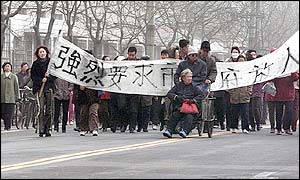
Unrest has taken the form of disaffected ethnic minorities battling police; farmers staging protest to fight dam projects; overworked textile workers organizing strikes; retirees demanding pension payments; laid off workers demanding their jobs back; and villagers blocking road for days and demanding redress over the seizure of land. In most cases the protests are set off by a particular event and are not necessarily oriented towards the party but are sometimes handled as if they were.
Barbara Demick wrote in the Los Angeles Times, Protests in China have become relatively common over issues such as corruption, pollution, wages, and land grabs that local officials justify in the name of development. People have become increasingly unwilling to accept the relentless speed of urbanisation and industrialisation and the impact on the environment and health. Many of the protesters are poor victims of the transition to a market economy who have suffered and have been unable to protect their rights with the protests and riots a release of pent up frustration over things like corruption, police abuse and the unequal distribution of wealth. A porter at the center of riot in Wezhou told the New York Times, “Our society has a short fuse, just waiting for a spark....People can see how corrupt the government is while they barely have enough to eat.”
The courts and government agencies are so ineffectual in dealing with problems that villagers and people who have been wronged often have little choice other than to take their cases to the streets. Through the use of cell phones and text messaging rumors and reports of outrageous act can spread rapidly and quickly mobilize a crowd into a mob. Information that is spread this way is often untrue or exaggerates the circumstances and riles people up and into action.
Analysts have suggested that one reason there are so many protests is because there is a lack of unifying movements such as Poland’s Solidarity. The result is a lot of small, localized expressions of discontent.
Chengguan officials, widely disliked in China and often accused of using excessive force against civilians, have been behind an increasing number of riots in recent years. Many of China’s problems — the seizure of land from peasants, workers forced to work under sweatshop conditions and factories spewing out pollutants — have their roots in local corruption and abuses by local officials which in turn have their roots in the TVE systems. See local government.
Han Dongfang on Demonstrations in China
Han Dongfang, a leader of the 1989 Tiananmen Square , wrote: “Young people today do not care as much as the students of 1989 about the fate of their country or their fellow citizens, or set much store by democracy, freedom and political ideals. Instead, they want to find a good, well-paid job, and dream of owning a car and buying a home as soon as possible... There is no inherent conflict between the pursuit of a comfortable life and the pursuit of democracy and freedom. Democracy is not just a matter of abstract political theory. A democratic system should be able to deliver a better life - decent pay, a good job, a nice car and a place of your own - as a matter of course. It should be a tool for realizing dreams. At the moment, how many of the 1.4 billion people living in China are really fulfilling their dreams? Never mind dreams - how many still lack life’s basic necessities? [Source: Han Dongfang, mingpao.com, June 4, 2009]
“Today, countless Chinese people see protest as a means of realizing their modest dreams of affluence, or reclaiming their usurped economic rights from corrupt officials, crooked businessmen and unscrupulous employers. Though it has little to do with democratic theory or sloganeering, this process has become unstoppable. Is this not a continuation of the campaign we launched 20 years ago, and an extension of the 1979 Democracy Wall movement and the protests of 5 April 1976? We might even see this as the resumption of the lofty work of countless Chinese citizens since the Reform Movement of 1898 and the 1911 Revolution. The difference today is that protestors will not lightly risk their lives or a long jail-term to achieve their goals.”
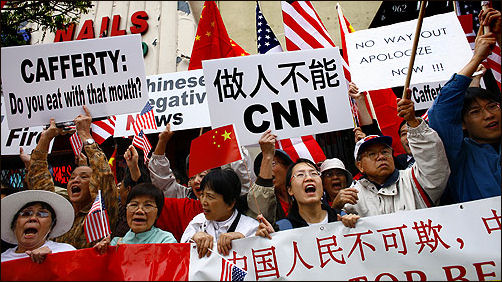
Building Tensions in China
Will Clem wrote in the South China Morning Post, “The drive to gain personal wealth and the material trappings it brings has become the paramount goal. Employers talk about the difficulty of retaining staff who are willing to jump ship to a rival for a negligible increase in pay - even if that means longer hours and poorer working conditions. In one of the most extreme examples, a high school student in Anhui province sold one of his kidneys for 20,000 yuan so that he could buy an iPad 2. [Source: Will Clem, South China Morning Post June 25, 2011]
In just the past month, there has been rioting in Guangdong and Hubei provinces and Inner Mongolia , bombings of government buildings in Tianjin and Jiangxi province, and clashes in Zhejiang over land compensation issues.
Seasoned China-watchers have been starting to mutter about a gathering storm. There is a growing sense of a country in danger of pulling itself apart at the seams, and the authorities' ever more heavy-handed response seems only to sow the seeds of yet greater resentment.
Shanghai government insiders privately admit they are feeling immense pressure due to worries about upsetting public opinion and the need to listen to grassroots opinions - something they admit has been a novel experience. A populace that once blindly accepted decrees is becoming increasingly vocal about standing up for its own interests, and demanding a bigger piece of the pie.
Ordinary Chinese are less worried. Most respondents to a Bloomberg poll felt confident of the Chinese government’s ability to fend off demands for greater political liberalization. Just 1 percent expect a political crisis within the next year and 27 percent expect one within the next two to five years. [Source: David J. Lynch, Bloomberg, Business Week January 26, 2011]
China Poised for Implosion?
“In the last 3 decades, China has raced to become the world's second largest economy yet questions about its political stability have arisen due to population trends and the high degree of inequality,” Howard Friedman wrote in the Huffington Post. “The path to stability or instability is heavily paved with questions about China's ability to maintain economic growth in light of wage pressures, unemployment/underemployment of its exploding college graduate population, increasing social and health needs of its aging population and China's projected declining support ratio. An economy that continues to grow at its current pace with minimal inflationary pressure would likely remain stable while slowdowns in economic growth or major increases in inflation would likely add gasoline to a smoldering fire of discontent.” [Source: Howard Friedman, Huffington Post, August 23, 2010]
“High degrees of inequality are correlated with many issues in society and can ultimately lead to political instability as evidenced countless times in history. As Ole Schell, director of “Win in China” pointed out, “Mao's revolution was born out of this same inequity and the Chinese government is trying to modernize the countryside in an effort to quell discontent.”
“While correlation does not mean causation, cross country data analysis such as that in The Spirit Level strongly suggests that unequal societies are more likely to have higher rates of murder and incarceration and lower levels of trust and social mobility. China's wealth inequality reflects the fact that while a small percent of the population are benefitting greatly from the economic growth, that privileged population is largely confined to the educated and/or politically connected residents of major cities.”
“A significant amount of China's population is trapped in rural poverty or toilsome factory labor with minimal chances of social mobility. As Chinese workers clamor for greater pay and increased rights, factory owners pursue profits by seeking out areas with lower wage pressures. Safe and humane working standards, which laborers fought so hard for in the West, are often absent in developing countries like China, leaving workers susceptible to conditions which Western countries haven't seen on a large scale in generations. Inequalities also exist within the workplace, where migrants often experience lower status, less job stability and lower wages than locals. This struggle between the working class and management/owners is a classic refrain of capitalist societies documented by Marx and Engels.”
Rural parents often see their children moving to urban areas to find factory employment where the income and opportunities usually exceed those available in their hometowns, but many question whether the quality of life is superior. Food and housing price inflation are reducing the purchasing power of factory worker's compensation, making it more difficult to send savings to their families. In other circumstances, parents (and often grandparents) support their child's college education only to later see that the graduate either can't find work or the work didn't require a college degree.
China's income inequality and opportunity inequality will be driven to a sharp focus in the world of marriage and relationships. Due to a combination of sex selection and the natural tendency of more boys being born than girls, there are currently around 25 million more Chinese males less than 20 years old than Chinese women of the same age range. In the next few decades, this lack of female counterparts may result in more men emigrating, more women from neighboring countries immigrating to China and, will likely lead to many frustrated and angry Chinese males.
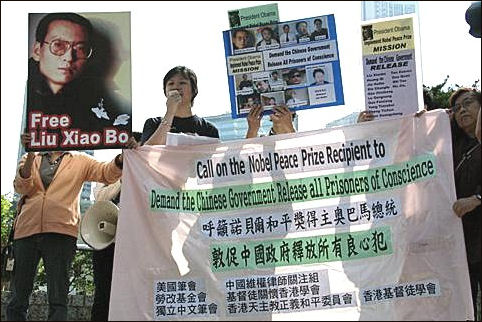
Protests and Demonstrations and the Chinese Government
The Chinese government is worried most about localized discontent spreading and coalescing into large-scale opposition to its rule. A report to the Central Committee in 2004 urged local officials to give the issue attention because “the life and death of the party” was at stake.
The Communist Party has blamed the unrest on subversives and foreign agents but has acknowledged that at least some of the protest have emerged to address legitimate grievances.
The Chinese government has ruled out democratic reform as an option and instead has chosen to exert more influence on local leaders, making them more accountable for their actions.
Beijing has approached each protest on a case by case basis addressing demands in some cases and cracking down on others or using a combination of both approaches.
The government has tried to control information by restricting access and censoring the news but has been unable to stop the flow of information through the Internet and cell phones,
The government provide more generous social services to urban areas than to the countryside in part because it fears urban social unrest, which can become organized, spread and gain momentum and present a real threat to the government. By contrast rural unrest tends to be fragmented, scattered and easier to contain once its gets started.
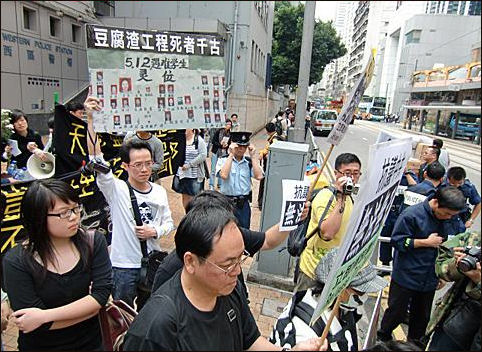
Protests, the Internet and Text Messaging in China
When some news events happen, such as a large protest, coverage on television and in the press are blocked by the government while accounts and pictures quickly make their way to the Internet and are circulated on chat lines and forums. The government often tries hard to stop it but there are simply too many sites and ways to avoid censorship and there is no way the government can control all the Internet.
Websites and blogs were vital in disseminating information about SARS, the Harbin benzene spill and protests and riots. Once an issue finds an audience on Internet it can take on life of its own, generating huge interest, and sometimes forcing the government to act and change its policy. Coverage of the beating of college graduate in Guangzhou in 2003 and 2004, for example, led to reform of China’s detainment centers. An outcry over the leniency given a notorious gangsters resulted in the gangster being retried by the Supreme Court and executed. As of early 2006 there were an estimated 4 million to 16 million bloggers in China.
Microblogging Used in Protests
In many recent protests and riots, news has been spread on China’s Internet, especially on Sina’s popular Weibo microblogging site. Authorities are wary of discussion of discontent spreading, and by routinely block searches on Weibo for certain keywords, with a message saying the “relevant legal regulations” prevented showing the search results. The New York Times reported: “Public activism in China has surged in recent years, helped by the popularity of microblogs that allow rapid dissemination of information. Bloggers have swung into action on prominent cases such as the mysterious death last Christmas of an activist village leader and a train crash near the eastern city of Wenzhou in July that killed at least 40 people.
Sitting in her Nanjing hotel reading anti-government posts on her Blackberry and laptop, Ying Chan, the dean of Cheung Kong School of Journalism and Communication at Shantou University said: “In totalitarian states in the past, meetings among dissidents happened under a veil of secrecy. But here I was following the actions of these free-thinking strangers in real time without ever setting foot outside. In the age of the microblog, every mobile handset and computer is a news broadcast station, a node in a vast information network.” [Source: Lester R. Kurtz, professor of public sociology at George Mason University, Open Democracy, November 17, 2010]
Jaime FlorCruz of CNN wrote: “Despite the official censorship on China's cyberspace, observers credit the New Media for playing a unique role in galvanizing public opinion. The Chinese call this "weiguan" (surrounding attention, or kibitzing) — the use of the Internet and social networking sites by Chinese netizens to influence agendas by tweeting and retweeting opinion and focusing attention on issues and news events. Many times, "weiguan" has changed government policies and behavior. [Source: Jaime FlorCruz, CNN, May 1, 2011]
"The traditional one-way flow of information — from official media to the audience — is being altered by the multi-way flow of information online because of social media," says Bu Zhong, assistant professor at Penn State University. "The compromises that we've seen lately show how officials are learning to handle crises in the age of social media — suppression does not always work anymore. What's happening today was not conceivable in China 10 or 20 years ago."
Still, experts say, recent outbreaks of social unrest highlight the scarcity of legal avenues for people in China to participate in state affairs. "The need for social participation is growing but there is no channel or system for the society to participate," says Li Fan. "The result is political instability."
Dealing with Demonstrations and Showing Restraint
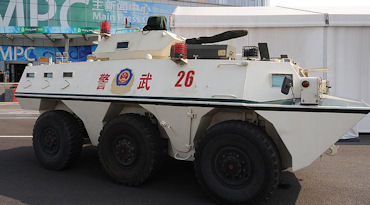
APC security vehicle “There's a clear lack of consensus in the party on how to deal with these protests,” Russell Moses, a China analyst based in Beijing told the Washington Post. “Usually that would lead to stalemate, but in this case it's an opportunity for experimentation about how to quell them effectively. This is first and foremost about information-gathering.” [Source: Lauren Keane, Washington Post, November 22, 2008]
“The party has always used two hands to deal with such crises,” Zhou Xiaozheng, a professor of sociology at Renmin University in Beijing told the Washington Post . “One hand arrests a few scapegoats, and the other hand tries to calm down everyone else. “During the 1989 crackdown on pro-democracy demonstrators in Tiananmen Square, “the party sent high-ranking officials to negotiate with the students, but they also sent troops,” he said. “It's still the same today.”
In November 2008, police were given orders to avoid inflaming riots. The Minister of Public Security issued a statement saying, “In handling mass incidents we must be clear that the chief aims of the public security authorities are to maintain order on the scene, ease conflicts avoid excessive steps and prevent the situation getting out of control.”
The statement was partly an effort to address to vehemence of the Wengan riot. After that the Chinese government vowed to crackdown on public officials who caused mass unrest by mishandling public complaints. According to a statement issued in July 2008, officials who “gravely harm the public’s interests, sparking major problems in petitioning or mass incidents” face demerits, demotion of dismissal. This was seen by some as a gesture to put on a good face before the Olympics.
Beijing Gives Occasionally to Protesters
Jaime FlorCruz of CNN reported in May 2011: “When hundreds of truckers went on a slowdown strike in Shanghai several days ago, the impact was immediately palpable: The movement of goods in one of China's largest container ports was virtually paralyzed. China watchers wondered how authorities would react. Will they send in the anti-riot troops? How soon will the heavy hand of the state come down? The crackdown did not happen. Instead, the Shanghai authorities agreed to reduce the fees imposed on the truckers, thus placating the strikers who complained that the fees were onerous, given the high inflation and fuel prices. The authorities blinked.”[Source: Jaime FlorCruz, CNN, May 1, 2011]
“The Shanghai strike, experts say, is not an exceptional case. In recent years, local officials in Beijing, Shanghai and Guangzhou have given in to public pressure — street demonstrations, silent "strolls" and online campaigns — on controversial issues. In some cases, government planners had to abandon plans to build chemical plants and waste incinerators when residents expressed concerns over environmental and health hazards. The gentle handling of these potentially explosive mass actions contrasts starkly to the harsh crackdown on political dissent. Over the past several weeks, Chinese police have rounded up scores of political activists, lawyers and bloggers, including Ai Weiwei, a prominent artist and political activist.”
So what is behind the kid's-glove approach to such mass actions like the Shanghai truckers' strike? "They are challenges to specific issues rather than ideologically driven, cross-regional organized events," David Zweig, political science professor at the University of Science and Technology in Hong Kong, told CNN. "They are citizens' protests, not political actions aimed at changing the regime or forcing political reform on the regime."
Political activists like Ai Weiwei, experts say, are viewed differently. "These activists have challenged (the regime) for a long time and would not compromise," Li Fan, a political scientist, told CNN. "That's why they are treated severely. They are like scapegoats, as we say — 'kill the chicken to scare the monkey,' because the government will not allow the emergence of leaders of the opposition."
Cracking Down on Protests and Demonstrations in China
Police Command Vehicle
Many of the riots and demonstrations end with large numbers of security forces being called in. The police round up a few dozen people accused of being leaders and declare tat order has been restored.
Police use rubber bullets and tear gas and occasionally electrified truncheons that resemble cattle prods. To disrupt protesters at Tiananmen Square water trucks have sprayed the square with water turned it into a large sheet of ice. Rarely is anyone killed. But that doesn’t the police are not rough. The paramilitary police that are called in have a reputation for being very fierce. One man involved in a protest told the New York Times, “They beat you even if you kneel down before them.”
Protest leaders have been sent to labor camps for organizing illegal demonstration against market reforms, corruption and the failure of the state to support workers and farmers it has pledged to serve. In recent years some hardline Communists have been sent to these camps
In July 2005, a front page editorial in the People’s Daily addressing a recent wave of protest told Chinese citizens to obey the laws and and warned that threats to social stability would not be tolerated. “Protecting stability comes before al else,” the editorial cautioned. “Any behavior that wrecks stability and challenges the law will directly damage the people’s fundamental interests.”
In January 2007, China’s top security officials said that local unrest is a serious problem that should be handled locally.
Chinese Protest Local Grievances and Get Results
Barbara Demick wrote in the Los Angeles Times, “I This might well be called the season of discontent in China. People, many of them middle-class homeowners, have been taking to the streets across the country in the last few months to air their grievances. At times, the protesters have turned violent — overturning police cars or smashing windows with baseball bats — but more often, they are engaging in civil disobedience. [Source: Barbara Demick, Los Angeles Times, October 8, 2011]
Unlike 1989, when calls for democracy ended in carnage at Tiananmen Square, today's demonstrations lack an overarching political theme.These demonstrators have a narrow agenda and concrete demands: Farmers want a stop to confiscations of their land or to get better compensation for lost property. Homeowners want to stop demolitions. People want cleaner air and water and safer food. Truckers and taxi drivers want relief from soaring fuel prices.
The increased number of protests does not necessarily reflect fragility in the system as much as a pragmatic approach by the Communist Party to grievances, said Ding Xueliang, a professor of sociology at the Hong Kong University of Science and Technology. "If there is no channel for people to express their anger, they will come to the conclusion that it is the political system that is repressing them," Ding said. "You need to leave some room for collective action. You can't just open fire every time people come out on the streets."
The protests have been localized, with virtually no coordination between them, one reason the government has been relatively tolerant. But the risks for Beijing are not insignificant: There is a danger that people will be inspired by example, because the issues are the same throughout China, and that the "micro-protests" will coalesce into something bigger.
"People are getting braver," said Liu Baojun, 45, a farmer who was among protesters who lay down in a cornfield in front of tractors that were clearing the land for a highway in northeastern China in May. "In the past, whatever the government told us, we believed and we would do what they said. Now we have information. We have books."
Many of the new protesters are homeowners or middle-class professionals. Doctors at Tongren Hospital in Beijing staged a one-hour strike in mid-September to demand better security after one of their colleagues was stabbed and critically injured by a patient.
Officials Sent to the Countryside to Quell Unrest
In March 2012 Leo Lewis of The Times wrote: China has sent 15,000 officials into the countryside to curb unrest and prevent petitioners heading to the capital before a leadership change in the autumn of 2012. The huge scheme is designed to ensure a buffer of stability in northern Hebei province that surrounds Beijing, as the National People's Congress meets for its annual session. [Source: Leo Lewis, The Times, March 2, 2012]
The mass redeployment of officials underscores Beijing's determination to ensure that no unrest disturbs the image of a smooth transition of power when a new leader of the Communist Party is appointed at a congress later in the year. Zhang Qingli, the Hebei party secretary, justified the decision to divert officials from their office jobs to live with farmers for the next eight months with the warning: "If the foundation is unstable, both the earth and the mountains shake."
Officials will be drawn from across all government departments in Hebei and will immerse themselves in the lives of the province's 5010 farming villages. A document issued by the Hebei Communist Party Committee said: "The mission of the officials will be to help the countryside to develop its economy while maintaining stability to ensure that by the end of October no mass incidents take place."
Their task is also to reduce the number of petitioners going to the provincial capital and Beijing to seek answers to grievances that local officials have not addressed. The area around the main petition office in Beijing is patrolled by thugs hired by local governments who round up petitioners to prevent complaints reaching the ears of the central government.
Image Sources: BBC; China Digital Times, blogger Jessica
Text Sources: New York Times, Washington Post, Los Angeles Times, Times of London, National Geographic, The New Yorker, Time, Newsweek, Reuters, AP, Lonely Planet Guides, Compton’s Encyclopedia and various books and other publications.
Last updated November March 2012

